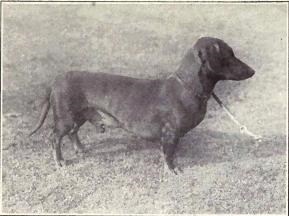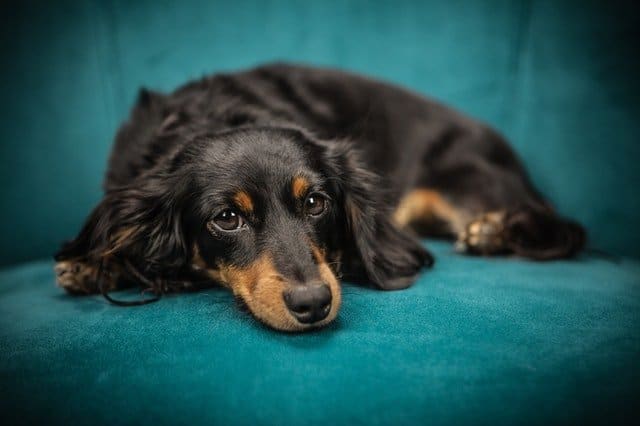The long-bodied, short-legged dachshund that we know today hasn’t always been this way. Let us look at the history of dachshunds.
The original appearance of Dachshund

The original dachshunds did not look quite like the one’s today. For one, they had longer legs and shorter necks than they do now.
Today, because of breeding dachshunds by exaggerating features just so that they look cute, dachshunds have long bodies, short legs, and long necks which makes them look jutted forward.
Because of this body shape, dachshunds are also the most prone to Intervertebral Disc Disease (IVDD).
The modern dachshund

The dachshund we know today comes from 15th-century German y, which was refined again in the late 19th century.
The wire-haired dachshund had almost become extinct by the end of the 19th century, and it was restored by German breeders.
It was around this time that the standards for color, size, and shape were formed for the dachshund.
Body
The dachshund has a long and low body. With this type of body, the dachshund was able to burrow underground to look for badgers and other animals.
The dachshund has small stubby legs and a muscular body. The short legs make it closer to the ground, which means that they can follow trails easily with their great sense of smell.
It also helped dachshunds climb underground. The skin is fairly loose, which was important so that it didn’t tear easily if the dog was digging underground.
The tail of a dachshund is curved. This is so that it will be visible better among the tall grass while hunting. Also, if the dachshund got stuck at the entrance of the burrow, it was easier to pull it out with the help of its curved tail.
The dachshund has a deep chest. This is important because dachshunds need a lot of lung capacity to give them stamina while hunting and digging under the ground.
The dachshund has flappy ears that cover its ear canals, so as to not let any dirt and dust get easily into its ears.
Paws and teeth
The dachshund has front paws that are not proportionate to the rest of its body. The paws are quite large and are shaped like paddles. This helps dachshunds while digging, as well as while getting the game out of the burrow.
The claws and teeth of the dachshund are extremely sharp, which is necessary for hunting dogs. They have a bite that stings, immobilizing the prey for a while.
Coat
The dachshund has a coat developed to be able to tolerate the conditions on the field.
Dachshunds can have either a short ad smooth-haired coat, wire-haired coat, or long-haired coat.
All three coats are recognized by the AKC. Dachshunds with the long-haired coat were bred in places with a colder climate.
The wiry coat was developed for dogs who worked in places with thorny barriers.
Size
Dachshunds come in three sizes: standard, miniature, and rabbit. In most places, only the standard and miniature varieties are recognized. The rabbit dachshund is not recognized by clubs in the US and the UK.
A full-grown standard dachshund weighs 7.5 kg (16 lb) to 14.5 kg (32 lb) on average, while the miniature variety usually weighs less than 5.5 kg (12 lb). The rabbit dachshund weighs 3.5 kg (8 lb) to 5 kg (11 lb).
Types of dachshunds today
There are three types of dachshunds: short-haired dachshunds, long-haired dachshunds, and wire-haired dachshunds.
The original dachshunds were short-haired. The long and wiry-haired dachshunds were bred later when breeders realized that the dachshunds in certain regions could benefit from having those types of coats.
Short-haired dachshunds
Short-haired dachshunds have a smooth coat of short hair. This type of dachshund needs the least amount of grooming and maintenance.
They come in a lot of colors and patterns such as black and tan, chocolate, blue, fawn, wild boar, dapple pattern, piebald pattern. The dachshunds with the brindle pattern have dark stripes along with their long bodies.
Long-haired dachshunds
The long-haired dachshunds have smooth, silky hair, which is sometimes wavy in texture. Their coats are similar in color to the short-haired dachshunds. These dogs require a lot more grooming, as they shed quite a lot. They require a lot of maintenance.
Wire-haired dachshunds
These dachshunds have a rough, wiry coat of short hair. They have a bearded appearance, which looks very different from short and long-haired dachshunds.
Their coats come in black, tan, wild boar, and red colors, and some of the colors that the other two types of dachshunds have.
What is the origin of the miniature dachshund?
The miniature dachshunds were bred in the 1800s. They were used for hunting smaller games such as rabbits.
The burrows of rabbits are much smaller, so the hunters needed dachshunds that were smaller in size, and the standard dachshunds were much too big for those tunnels.
Today, miniature dachshunds are very popular pets, with their small size and adorable looks.
What dog breeds were used to make dachshunds?
Dachshunds were developed by selective breeding of the dwarf gene into taller hunting dogs.
Taller hunting dogs included Bloodhounds, Pinschers, Terriers, the Schweisshund (Hanover Hound), and the German Bibarhund. These dogs might have been used to develop dachshunds.
The dwarf mutations were bred until they got the short legs they were aiming for in their hunting dogs.
The exact type of breeds used to make a dachshund are not known exactly. However, there are a few possibilities.
For example, the smooth-haired Dachshund could have been a cross between a Pinscher and Bruno Jura Hound, between a Pointer, Pinscher and Brake Bloodhound, or the development of the St Hubert Hound.
The wire-haired dachshunds could have been bred by crossing the smooth-haired dachshund with wire-haired breeds like Pinschers and Terriers.
Similarly, the long-haired dachshund could have been bred by crossing a long-haired breed of Spaniels.
What happened to dachshunds during the war?
These popular dogs were suddenly outcasts after the 1st and 2nd World Wars. With their origin in Germany, the people in US and UK were against everything German for a while.
These dogs had to bear the hate as well. A lot of dachshunds were stoned and killed after the wars because they were seen as a symbol of Germany.
Origin of Dachshund
The exact origins of the dachshund are not very clear. Image of dogs looking like the dachshund have been found in ancient Egypt, however, some do not find this theory believable.
There have also been findings of dogs like dachshunds being found in Spain, ancient Mexico, and even Denmark.
The only thing clear is that small dogs with short legs have been bred in a lot of places around the world. However, the most likely origin of the dachshund is in German.
Where were dachshunds first bred?
The Dachshund originated in Germany in the 1500s. It got the name “Dachshund” in the 1600s. The dachshunds were bred for the purpose of hunting down badgers.
The badger was considered a major pest among farmers, as it ate the crops. The dachshund was trained to hunt down badgers, so it needed to be brave, strong, and intelligent in order to win against the badger.
England was one of the first countries which used the dachshund not as a hunting dog, but as a loving pet.
What were dachshunds bred for?
Badger hunting
The name “dachshund” literally translates to badger dogs. Dachshunds specialized in hunting down badgers. However, it was not an easy process.
Dachshunds accompanied hunters in the wild, trying to spot badgers. Once the badgers realized that there were humans around, they would go back to their tunnels to hide under the ground.
This is when dachshunds were sent after them. Since dachshunds hunt in packs, more than one dachshund was sent inside the burrows to try and trap the badger.
The fierce nature of the dachshund also meant that they usually came back with the animal.
The size and shape of the dachshund were made for this job. When the badger was trapped inside, there was going to be a fight in there, and dachshunds needed to be agile and small to fit in the tiny space while being able to move around.
The dachshund’s job wasn’t to kill the badger. Instead, it only had to bite it so that it would be immobilized and then get it to the hunters, who did the rest of the work.
Blood tracking wounded game
A lot of countries in the world require a tracking dog on the field. The dachshund is a top choice for the blood tracking game for years.
Because the dachshund has short legs, it is closer to the ground, which is why it can follow scents very quickly. They have a sharp sense of smell.
If an animal has been wounded somewhere, a dachshund will follow the trail of blood to locate the animal. The dachshund locates the blood on the ground which is nearly invisible to humans.
While tracking such animals, it is important for the dog not to get distracted by all the other smells in the wild.
Dachshunds, with their strong sense of smell, are good at differentiating the scents, which helps them to stay on track.
Woodchuck, fox, and other games
Dachshunds come in two sizes: standard and miniature. Based on their sizes, they are better suited for hunting other games.
Miniature dachshunds are known for hunting woodchucks, or groundhogs, which are suited for their size. Standard Dachshunds were bred to hunt badgers, which are larger in size.
Both miniature and standard dachshunds work together to catch prey. They also travel in packs, which means that there are likely all sizes of dachshunds in one pack.

